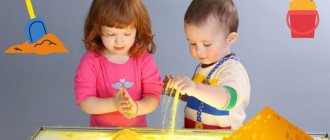The benefits of painting with paints for children
One of the popular creative options for preschoolers is fine art. Teaching a child to draw from an early age has a positive impact on the formation of his personality, helps to develop not only imagination, but also abstract thinking.
The benefits of practicing this type of creativity:
- Development of fine motor skills. Artistic activities require movements of the fingers and hand, which activates areas of the brain responsible for speech, thinking, coordination, and memory. During the drawing process, both hemispheres work, which helps strengthen the connections between them.
- Self-expression. Through drawing, the child projects his inner state onto paper. He expresses thoughts and feelings that he cannot or does not want to express. This allows you to get emotional release and lift your spirits.
- Developing the ability to identify priority goals. In the process of creativity, the child receives a result - a painting. This teaches him to set goals for himself, compare early achievements with past ones and work to improve them.
- Developing patience and perseverance. Systematic painting lessons and working on each drawing teach the child discipline and help structure time.
- Increased self-esteem. Creative activities allow a child to distinguish himself among his peers and feel important.
- Development of creativity. Drawing teaches abstract thinking and contributes to the formation of an individual view of things. Painting not only develops imagination, but also helps to find practical application for new skills.
- Understanding the world around us. Through creativity, the child learns to understand that people can perceive the same objects or phenomena differently and experience different emotions towards them. This develops empathy and social skills.
- Introduction to culture. Learning to draw develops children's taste and aesthetic perception.
- Positive impact on the psyche. Painting classes calm, pacify, and provide an opportunity to productively use accumulated energy. Art lessons are especially useful for children who are aggressive, moody or prone to depression.
In the process of learning to paint, spatial and associative thinking develops, skills of projection onto a plane and orientation in space are developed. This contributes to the mastery of other school subjects and scientific disciplines: mathematics, chemistry, physics, geography, drawing, etc.
Optimal age for skill development
It is best to start teaching children the basics of drawing from an early age - from 6 months to 3 years. During this period, the child should learn the basics, but targeted lessons are not required.
It is enough to provide everything necessary for the development of creative abilities. Games with finger paints improve fine motor skills, imagination, and creativity, which has a positive effect on the formation of not only artistic skills, but also personality.
Targeted drawing training can begin at the age of 5-7 years. During this period, the creative process becomes more meaningful, the child learns to compare and cognize, improving his skills.
Creating a painting turns from a game into a conscious action. At this age, you can begin to work with different types of paints and paper, drawing techniques. This will help you understand what the aspiring artist has the most ability and desire for.
Learning the art of drawing in a playful way.
How to teach drawing to a child from 5 to 7 years old?
At the age of 5 to 7 years, a person’s self-esteem is formed through achievements in creativity and sports. He begins to be proud of himself and become confident in his abilities, which is useful in preparing for school.
The main thing at this age is to praise for any drawing, hang the work on the wall and let the child be proud of his result.
Do not correct or complete the child’s work, praise him for each drawing so that he wants to draw more and more.
Preschool children are restless, so draw for no more than 30 minutes. Do not force the child to finish the drawing unless the child himself wants to finish what he started.
At the age of 5 to 7 years, all drawing techniques are available:
- Watercolor;
- Pastel;
- Sketch;
- Oil painting;
- Pencils;
- Markers;
- Wax crayons.
Do you want your child to develop artistic talent and learn new drawing techniques? Sign him up for an art class. To avoid making a mistake with your choice, follow our recommendations.
Choose several schools and studios that suit your location and price. Visit them so you can feel the atmosphere and talk to the teacher. Ideally, go to his class and watch how he conveys information to the children.
The cost of drawing courses in Moscow and St. Petersburg varies from 1,500 to 15,000 rubles. It all depends on the number of hours. Some courses involve drawing a specific design and last several hours, while others involve diving into artistic techniques over several sessions.
Teaching your child to draw with the help of courses is easier and more effective. The courses awaken the child’s interest in creativity. They are like an exciting adventure, and new every time.
The best way to teach a child to draw is at an art school. However, it is necessary to enroll in it if the child wants to devote himself to a creative profession and develop in this direction.
Tell us in the comments what difficulties you encountered while working with your baby? Share the article on social networks so as not to lose game drawing techniques with your child!
This training may be right for you:
- Best Online Drawing Courses for Kids
- Best Children's Activities in St. Petersburg from 1,500 Rubles
- 10 Best Drawing Courses in St. Petersburg
- Best Educational Activities for Children
What paints are best for children's creativity?
When teaching a child to draw from scratch, it is important to choose the right paints.
The most common types used for children's creativity:
- Finger paint. Made from food coloring and water. Safe for health, easy to wash off, wash and clean from any surface. They have a thick consistency, so they stick well to your fingers and lie smoothly on paper. Suitable for babies aged 6 months and older.
- Watercolor. The most common option for beginning artists, which is most often used in kindergartens and schools. Watercolor paints are made from environmentally friendly materials, are easy to use, and have a bright and rich palette. They easily mix with water and lie on paper in translucent layers, while maintaining richness and juiciness.
- Gouache. Suitable for children aged 5-7 years. It has a dense texture and bright colors when applied to paper. The composition can be either safe or containing toxic substances. For children it is better to choose the first option.
- Oil paints. Valued for ease of use, ease of mixing, and durability of the pattern. They dry without changing color, unlike acrylic or watercolor. Made from vegetable oils. Since economical consumption is important when using such pigments, they are best chosen for children 6-7 years old who are already familiar with the basic rules of painting.
- Acrylic paints. Manufactured from synthetic components. They dry quickly, are easy to dilute and mix, and are suitable for drawing not only on paper, but also on wood or fabric. Acrylic paints are chosen for children 6-7 years old who have already mastered the basics of watercolor painting.
It is better to avoid too bright, acidic tones. Colors should be moderately saturated. The optimal set for a child 6-7 years old is 12-20 shades. Before purchasing, it is recommended to check the paints: they should be moist, uniform in texture, without a sharp, pronounced odor.
Watercolor paints.
Drawing objects step by step
It will be easier for your child to learn if you ask him to depict individual elements step by step.
Geometric figures
First, they start with geometric shapes, from which you have probably already made colored applications. If the child manages to draw the lines more or less evenly, you need to show how to make an oval or circle, and then turn it into a picture. After this, you should invite the child to get the drawing himself, for example, turn it into a face.
At an older age, they begin to study three-dimensional figures - cubes, parallelepipeds.
Tree
If your child has mastered simple techniques, you can start a tree drawing lesson. It is formed from circles and straight lines, and a crown is also depicted. Gradually they learn to draw individual leaves.
All this is done in several stages:
- Creating a basic frame.
- Shaping.
- Coloring inside the outline.
The child independently draws the branches, leaves, and trunk. You can tell what grows on the ground, depict bushes, and clouds and the sun above the tree.
Flower
The flower is drawn in the following way:
- Start with a small circle.
- Leaves of a characteristic shape are made around the core.
- Represent stems.
- Paint each element in the appropriate color.
To get an interesting design, you can use a fork, dip it in paint and apply it to a sheet of paper to make petals.
It will be even easier if adults draw the stems and let the child work on the petals. By the way, in this case the brush can be replaced with cotton swabs.
Animals
We teach children to draw animals using the example of a bunny, a frequent character in fairy tales:
- We make an oval that will act as the body.
- We form a second smaller one for the head.
- Along the edges below we draw 2 circles for future paws.
- Below them are 2 more for the feet.
- Next we move on to the ears and tail.
At the end, all that remains is to add eyes, a nose and color the hare.
House
You should start with a square, it will be the basis. A triangle is suitable for the roof. Inside the large one there is a small one, which will become a window, as well as a rectangle in the form of a door.
When your child can draw such a house, it’s time to pay more attention to details: add a frame to the window, a pipe to the roof, and a handle to the door. You should also familiarize yourself with the features of drawing the horizon line. The upper part depicts the sky, sun and clouds.
The lower part is the ground. It is painted green, flowers and trees are drawn. The child decorates the house itself at his own discretion.
Vegetables and fruits
Learning to draw vegetables and fruits begins at the age of 5-7 years. The easiest way to depict a watermelon is:
- Draw an even circle.
- Place a dot on top and draw a spiral that will be the tail.
- Draw lines from the base to the bottom of the circle.
- Color the watermelon itself green, and make the lines dark green.
At every stage it is possible and even necessary to help a young artist - of course, if he himself does not mind. To make it even more interesting, suggest solving riddles about watermelon.
Human
A person is depicted according to a certain scheme:
- Make an oval that will be the head.
- Below it is a rectangle for the upper body.
- These two elements are connected by smooth lines, adding a neck.
- A second one is attached to the rectangle. It should be more elongated.
- In the middle of the bottom, draw a line down to create the semblance of legs.
- Along the first one draw two more thin ones, which will be hands.
- In the upper part a smooth line of shoulders is depicted.
- After this, clothes and shoes, hands are drawn. Excess elements are removed with an eraser.
- Finally, facial features are formed.
The creative process should take place in a fun environment; it is important that the activities are not a burden to the child.
Other tools
For painting, you will also need additional tools.
Their list:
- Brushes. It is better to buy a set of several products of different thicknesses: this will make it easier for your child to realize his creative ideas. For watercolors, choose brushes with natural squirrel or raccoon bristles, and for thicker, more saturated paints, use hard tools with artificial bristles. The holder material that is most comfortable for a child’s hand is wood.
- Paper. For drawings by a novice artist, album sheets of A4 format are suitable. When the child gets comfortable with the basics, it is recommended to replace them with special paper for certain types of paints (for example, watercolor or gouache). This way the pictures will become more juicy and beautiful.
- Palette. This is a device for mixing paints. Made from plastic. On the palette, the child can mix different colors and get new shades without damaging the paper.
- Pencil and eraser. Needed for drawing contours. It is advisable to choose a soft pencil, especially when working with water-based paints.
- Water container. Any cup, glass or jar will do. If your child spills liquid, it is better to buy a special mug with a protective lid.
For convenience, you can purchase a special tablet holder for paper or a small easel. It will teach the child to draw without rotating the sheet, which will be a good help for further artistic training.
Brushes and palette.
What is graphics, how to learn to draw in this style
Graphics (pencil drawings for beginners in this style should be done on thick paper) differ from other styles of painting in the way they create an outline.
To draw objects in a graphic composition, it is necessary to use clear thin lines, sharp corners, as well as smooth transitions of shadows and penumbras.
In addition to straight lines, this type of fine art allows the use of dots, spots and strokes, with the help of which the inside of the drawn object is filled.
What you need to get started
To create drawings in a graphic style, a novice artist will need:
- a set of pencils , differing in the rigidity of the rod.
Soft pencils are recommended for shading or filling the inner area of the depicted object; hard pencils are used to create the main contour lines, and medium-hard pencils are needed to draw auxiliary lines, which must be removed at the final stage of creating the image;
- thick sheets of paper or cardboard of any format (thin paper is not recommended for creating graphic drawings, since their creation requires frequent use of an eraser, which, if handled carelessly, can make a hole in the working plane);
- stencils (necessary if a child or an adult who does not have even minimal experience in the fine arts is learning to create graphic drawings);
- an eraser made of high-quality rubber (the low quality of the material used in the production of the eraser negatively affects the properties of the final product - it smears the pencil over the surface of the sheet and does not completely erase erroneously drawn lines);
- ruler, compass, sharpener;
- original images (if a novice artist plans to start working by copying ready-made illustrations).
Basics
When creating images in a graphic style, artists adhere to a number of basic principles:
- contour lines should be perfectly straight, except in cases where the bends are natural for the depicted object (you can learn how to draw straight lines like this: put 2 points on the opposite sides of a sheet of paper, and then, without lifting the pencil from the sheet of paper, connect them with one straight line) ;
Graphics - pencil drawings for beginners require compliance with a number of recommendations
- If possible, draw all geometric figures without lifting the pencil from the surface of the paper;
- using shading (in this case, regular exercises to develop the ability to hold a pencil correctly, painting the required area of the working plane, will help);
- the use of tonal stretching, which involves a smooth transition in the color intensity of a simple pencil or marker, due to varying the pressure on the stationery used.
From simple to complex
It is necessary to organize the work process in such a way that the complexity of the exercises being performed moves from simple to complex. For beginners, it is recommended that they limit themselves to creating drawings of geometric shapes, dishes or simple plants. After these types of images have been mastered, the artist should learn to draw landscapes, animals or portraits of people.
Only by setting feasible tasks for oneself, and regularly coping with them, can a person learn to create graphic drawings for a long time. Otherwise, he will quickly lose interest and stop studying, creating negative associations with creative activity for the rest of his life.
What should drawings be like for children 6-7 years old and older?
In the drawings of preschoolers and children aged 6-7 years, a clear plot and design begins to be visible. The basis for it is often everyday and social situations from the child’s experience: communication with family, playing with friends at school and kindergarten, visiting a store, hospital and other public places.
Often, motifs from fairy tales or cartoons can be traced; the child depicts literary characters, animals, and familiar places. Children 6-7 years old also draw household objects: furniture, dishes, etc.
The picture of a child reflects his inner state and worldview. Child psychologists advise paying attention to the general mood of the image: it should not be aggressive or depressive.
The constant presence of such motives (sad or quarreling people, large teeth and claws in animals, etc.) may indicate psychological problems.
At 6-7 years old, children should have basic drawing skills. Clear lines with strong pressure, shading and shading that do not go beyond the contour, recognition of the objects and ideas that the artist tried to convey, testify to his correct development.
If the drawings do not meet these criteria, there may be both psychological and physical problems, such as vision problems, neurological disorders, or poor fine motor skills.
Free drawing.
How to choose a drawing plot for preschool children
When choosing a painting theme for a child, you need to take into account 2 factors: the level of his skills and personal interests.
Popular drawing subjects for preschoolers:
- scenes from fairy tales;
- situations from the life of family and friends;
- visiting public places;
- landscapes, scenes with animals;
- the work of people of various professions - doctors, cashiers, rescuers, etc.
When choosing a plot, it is important to leave the child freedom for creativity. The topic should guide the student's imagination rather than limit it.
Fairy tales.
Palm drawings
Handprint painting is a good way to develop creative thinking in young children.
For this purpose, special paints are used that adhere well to the hand, leave a clear imprint on the paper and are safe in case of accidental ingestion.
With your palms you can draw:
- flower petals;
- branches and crowns of trees;
- other plant parts, such as carrot tops;
- fish, jellyfish and octopuses;
- animals - 4 fingers will be “paws”, and the remaining one will be the tail.
Later, various details are added to the resulting silhouettes with fingers or a brush. The child can do this either independently or with the help of his parents. Drawing with palms develops abstract thinking and helps to see different objects in one simple form.
Palms are an excellent drawing tool.
Drawing techniques for children
A different approach is used for training. There is no need to give the child a task, he should express himself freely. Once you learn how to use the tool, you can proceed to the next stage.
Finger technique
Paint is required for training. A child can dip their palm and leave prints on a piece of paper. Then he will learn to draw dots and lines.
They also master the technique with the help of semolina or corn grits, depicting pictures. To add interest, you can change the color with food coloring.
By points
Dot pattern is suitable for children aged 5-6 years. This promotes the development of motor skills and spatial imagination, prepares the hand for writing, and improves the functioning of small muscles of the hand.
First, they resort to simple drawings with dots along the contour. To make it easier for the baby, the parent can connect them with dotted lines. When tracing becomes easy, drawing techniques for children can be made more complex by using straight, curved and wavy lines. The child must trace them without taking his hands off the paper.
By the numbers
It won't be possible to do everything right right away. The technique with numbers is used at the age of 6-7 years. It increases interest in mathematics, multiplication in poetry and ensures the development of creative abilities.
The technique is based on turning numbers into an object or animal. For example:
- from the three they draw a snowman;
- from two - swan;
- five are turned into kangaroos;
- Six is transformed into a cute puppy.
In this way, the child expresses his imagination, embodying images from his head on paper.
Step-by-step creation of drawings by children
The most important thing in learning any type of creativity is constant practice. Before learning to draw complex, intricate paintings, a child must gain an understanding of simple shapes and the basics of composition.
At the initial stage, learning from ready-made sketches and step-by-step instructions is best for mastering the basics.
They should not limit the imagination and desires of the young artist, but only guide.
Snowflakes and winter ornaments
The image of snowflakes develops imagination and abstract thinking well.
Procedure:
- Draw a circle. Place a dot in the center.
- Focusing on it, cross out the circle horizontally, vertically and twice diagonally - you should get 8 lines inside. This will be the base of the snowflake.
- The blank is filled with circles, lines, zigzags, polygons and other shapes, creating an individual pattern. Similar actions are performed with each beam, maintaining symmetry.
It is worth giving your child creative freedom and the opportunity to draw according to their individual skill level.
Winter motifs in drawings.
Red Apple
Images of fruits and berries are the basis of most educational programs. Using their example, the child understands the basics of lighting and darkening, and color selection.
Steps for drawing a block:
- Draw a circle. Adjust the shape of the top and bottom parts to create the silhouette of an apple. Draw a line (“dimple”) in the upper part, mark the stalk and leaf.
- Apply the first layer of watercolor. It should be light, almost transparent. The apple can be decorated in green, yellow, red colors or a combination of shades at the child’s discretion.
- Color the fruit in a basic tone, skipping areas of highlights.
- Starting from the top of the apple, apply shadows, adding specks of paint and gradually stretching them with a brush.
Having completely painted the base, they begin to draw the stalk and leaf, thicken the outline and other finishing touches.
Fruit still life.
Watermelon gouache
Drawing a watermelon is another easy way to become familiar with basic shapes in painting.
Step-by-step instruction:
- Draw a triangle. Erase one of its sides and replace it with a semicircle, and also make the opposite vertex rounded.
- Inside the resulting outline, select the peel and the layer between the peel and the pulp.
- Paint the main part of the watermelon red. Highlight the layer between the pulp and the peel in green, making a smooth transition.
- Color the peel deep green. Add some dark stripes.
Lastly, you can add a few dark brown and yellow watermelon seeds.
Drawing landscapes
Using paints, it’s easy and quick to paint landscapes - from forests and mountains to the sea or the night sky.
The specifics are different, but the technique remains the same:
- Draw a pencil sketch. It should be as simple as possible and indicate only shapes, without details.
- Paint the background with primary colors: for example, sea and sand or field and sky. Draw large objects such as plants or mountains.
- Apply shadows and highlights. Add surroundings: clouds, waves on the water, etc.
Lastly, small details are completed: seagulls in the sky against the backdrop of the sea, fruits on the trees, etc.
Landscape with colors.
Other beautiful drawings
Both color and black and white versions can be used as drawings for joint creativity with children (depending on what working tools the young creator currently has).
| Image option | Creative process algorithm |
| 1. Draw a semicircle with a soft pencil, convex downwards. 2. Connect the top points of the semicircle with a straight line. 3. From the bottom edge of the semicircle, draw a vertical line, 3-10 cm long (depending on the scale of the image). 4. From the end of the vertical line, draw horizontal lines to the right and left, smaller in size than the main line, but equal to each other. 5. Inside the semicircle, stepping back about 5 cm from the top edge, draw a wavy line simulating the water level in the glass. 6. If desired, add eyes and mouth to the glass, making the drawing more creative. 7. Trace the outline of the drawing. 8. Color the picture in any colors that the child chooses. | |
| 1. Draw a circle in the center of the work surface. Trace the outline. 2. From the upper surface of the main circle, draw 2 identical semicircles (ears). Inside these circles, draw 2 smaller circles. 3. Inside the main figure, at the bottom edge of the circle, draw a smaller circle. 4. At the top edge of the inner circle, outside it, place 2 bold dots (eyes). 5. Draw a small circle inside the inner circle at the top edge. Inside it, draw a circle smaller in size. Paint the space between the main border and the edge of the inner circle (nose). 6. Draw a vertical line down from the resulting nose. Draw a downward curved semicircle so that this line divides it in half. |
Drawn by children with a pencil or felt-tip pen, simple but beautiful images develop creative thinking and also teach the growing person perseverance and accuracy.
By asking a child to create a drawing according to an existing pattern, an adult instills in him the ability to strictly follow instructions and work painstakingly to achieve his goal. Such skills not only contribute to the overall development of the young creator, but will also be useful to him in the further learning process.





